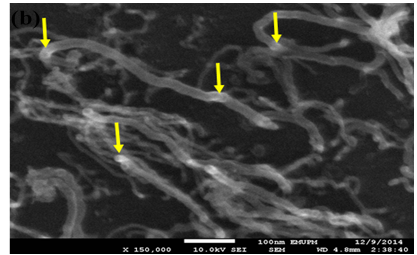Effect of Time on the Syntheses of Carbon Nanotubes via Domestic Oven
Keywords:
Plasma, Raman, Coated silicon, Polyethylene and QuartzAbstract
In this study, carbon nanotubes (CNTs) were synthesized directly on coated silicon substrate via commercial microwave oven at 2.45 GHzf for3 minutes (Sample A) and 4 minutes (Sample B). The plasma provides the required temperature for catalytic decomposition of carbon source (polyethylene) at 750 ?C under atmospheric pressure. Raman spectroscopy, Field Emission Scanning Electron Microscopy (FESEM), High Resolution Transmission Electron Microscope (HRTEM), X-ray diffractometer (XRD) techniques are used to characterize the as-synthesized. Results indicate that, the calculated carbon quality was found to be 1.01 and 1.02 for sample A and sample B respectively with average diameter range of (6.0 to 10.0) ± 0.5 nm. The high intensity ratio is attributed to the defect mode in the CNTs. Also, the analysis from FESEM shows twisted and randomly oriented structures with an interlayer spacing of about 0.35 nm in the internal structure of most CNTs. HRTEM further confirmed the interlayer spacing of about 0.35 nm corresponding to FESEM result. The crystallinity of the CNTs was obtained via X-ray diffraction techniques. Lastly, the results indicate sample A and B produces CNTs, with sample B having more graphitic structure than sample A due to duration of synthesis process.

Published
How to Cite
Issue
Section
Copyright (c) 2022 Journal of the Nigerian Society of Physical Sciences

This work is licensed under a Creative Commons Attribution 4.0 International License.





